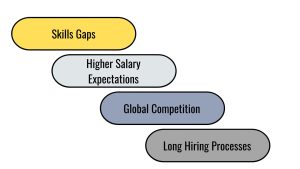Overcoming Hiring Challenges in a Competitive Market
Introduction In today’s job market, hiring the right talent seems like a monumental task. Skilled professionals are in high demand, and employers must compete to attract the b...

Introduction
In today’s job market, hiring the right talent seems like a monumental task. Skilled professionals are in high demand, and employers must compete to attract the best people in their field. As businesses grow, they require specialised skills and fresh perspectives, making it necessary to strategically address hiring challenges. One effective solution is team augmentation. Here, we look at common hiring challenges and proven strategies for overcoming them, especially when supported by augmented teams.
Understanding the Root of Hiring Challenges
Before diving into solutions, it’s important to recognise the root causes of hiring challenges. Several factors contribute to this competitive hiring environment:
- Skills Gaps: Many candidates lack the specific skills that companies need today, especially in tech and other fast-growing sectors.
- Higher Salary Expectations: As demand for talent increases, so do candidate salary expectations.
- Global Competition: Remote work has opened up the talent pool worldwide, making it even more difficult for candidates to stand out.
- Long Hiring Processes: Long hiring processes lead to candidate attrition, as they often find other opportunities faster.

Companies that understand these challenges can develop effective strategies to overcome them.
Leveraging Team Augmentation to Address Skill Gaps
One of the most effective ways to overcome hiring challenges is team augmentation. By bringing in extended team members, companies gain access to specialised skills quickly and with less commitment than hiring full-time employees. This approach bypasses lengthy hiring processes by filling skill gaps with qualified individuals who are ready to contribute immediately. Augmenting your team can provide skilled individuals for short-term projects or specific tasks without the need for extensive onboarding. This is especially useful in highly technical fields where finding the right expertise is challenging. Augmented teams often come with industry experience, and they can provide valuable insights that improve project outcomes.
Attracting Top Talent with a Compelling Employer Brand
Building a strong employer brand will help you stand out in the job market. Candidates today are looking for more than just a paycheck; they are looking for companies with clear values, a strong culture, and opportunities for growth. Companies that invest in a positive workplace culture and effectively communicate their values attract higher-quality candidates.
A compelling employer brand should demonstrate your commitment to employee development, work-life balance, and innovation. Share stories of current employees and extended team members who contribute to your company’s success. Positive stories show potential candidates what it’s like to work for you, whether they’re joining as part of an internal or external team.
Shortening the Hiring Process to Avoid Candidate Drop-Offs
Speed matters in today’s hiring environment. Long, drawn-out hiring processes can cause candidates to lose interest or take other offers. To stay competitive, companies should focus on a streamlined hiring process. This could mean fewer interviews, faster feedback, and setting realistic deadlines for hiring decisions.
Team augmentation can also be a solution. By bringing extended team members to meet immediate needs, companies can reduce the urgency to hire full-time employees immediately. This gives them time to find the right candidate without sacrificing productivity.
Expanding Your Talent Pool with Remote and Augmented Teams
One of the major changes in the hiring landscape has been the adoption of remote work. Companies can now hire from a global talent pool, finding the best skills regardless of location. Using remote team or augmented team members allows you to broaden your talent search and work with professionals who may not be available on-site but have the knowledge you need.
Working with remote augmented teams can also reduce hiring costs. Companies can avoid relocation costs and gain access to highly skilled professionals at competitive rates in their regions.
Offering Competitive Salaries and Benefits
Attracting top talent often means meeting their salary expectations. However, offering competitive compensation goes beyond base salary. Many candidates are looking for comprehensive benefits, professional development opportunities, and flexible work arrangements. By understanding candidates’ priorities, companies can create attractive compensation packages that set them apart.
For those facing budget constraints, team augmentation offers a cost-effective alternative. By hiring external team members to complete specific tasks, companies can complete projects without the long-term financial commitment that comes with full-time hiring.

Focusing on Skill-Based Hiring
Traditional hiring often focuses on degrees or previous titles, but a skills-based hiring approach prioritises what candidates can actually do. This approach broadens your talent pool to include non-traditional candidates who can bring valuable skills and fresh ideas. Companies benefit by finding people who are a good fit for their needs rather than looking solely at formal qualifications.
Implementing skills-based assessments can also streamline the hiring process by reducing the time spent on interviews. When working with extended team members, skills-based hiring ensures that external talent brings the exact capabilities you need for the project.
Investing in Learning and Development
Another way to overcome hiring challenges is to create a culture of continuous learning. When you provide opportunities for skill development, employees and augmented team members are more likely to remain engaged and perform at their best. Upskilling also allows your team to keep up with changing industry demands.
Learning and development initiatives can also help fill skill gaps within the company, reducing reliance on hiring. When you have internal training programs, it becomes easier to transition new team members or extended team members into roles where their skills are most needed.

Conclusion
Overcoming hiring challenges requires a proactive approach that takes into account today’s competitive environment. By implementing strategies such as team augmentation, skills-based hiring, and a flexible workforce model, companies can attract top talent and remain competitive. Working with extended team members allows companies to access the right skills, maintain productivity, and build a resilient workforce.
As the market evolves, adapting your hiring strategy becomes critical. Companies that use these approaches – utilising team augmentation, building strong relationships with external teams, and prioritising a positive employer brand – can overcome hiring challenges and secure the talent they need for long-term success.